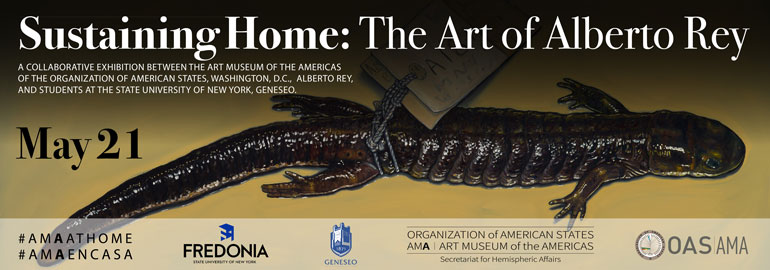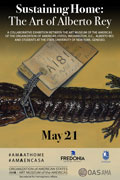
Jessica Pisano is a Senior at SUNY Geneseo, graduating Phi Betta Kappa, with an Art History Major and Minors in Museum Studies and Native American Studies.
On social media May 28, 2021
Las Balsas
Jessica Pisano
Alberto Rey’s art has recurring themes focused on the employment of symbolism and metaphors to represent peoples and places, which are important to him, as part of his personal journey as a Cuban-American artist. This creative and investigative strategy is particularly relevant in his Las Balsas Series (1995-89), which is based upon actual rafts and boats that once carried Cuban Refugees on the ninety-mile journey between Cuba and the United States. These journeys began in 1962 but increased significantly during and after the Mariel Boatlift Crisis of 1980. The rafts Rey represented, in this series, were inspired by the abandoned rafts and artifacts found at the Transit Center for Cuban Refugees, located at Stock Island, near Key West. On a visit to the Center, Rey was struck by how their existence and appearance evoked a status comparable to that of relics. Thus, this series can be understood as being a form of iconic altarpieces, which memorialize Cuban refugees. It is unknowable which of the rafts, Rey saw at the Center were found in the open waters off the coast of Florida, marking successful outcomes or how many were the rafts of those who perished at sea. Either fate is part of the background of the Cuban immigration crisis, which continues. Rey’s intention was to enact Las Balsas as an homage to the people who set out from Cuba in rafts or overcrowded boats, no matter their fate.
In his Balsas series, the rafts Alberto Rey depicts serve as symbols of the loss of human rights that lead to the departure of Cubans from the island, as well as the loss of peace and security that occurred before and during their journey towards a hoped-for better life. Thus, the rafts depicted in this series are images, which serve as metaphors for Cuban refugees and the traumas they faced during these dangerous ocean voyages. As metaphors of the danger, suffering, and fear experienced in the hope of seeking a better life. In Rey’s Las Balsas IV, Las Balsas IX, and Las Balsas XII, it is possible to see reflected a composite of the experience of those who set out on the rafts and the manner in which we, as Rey’s audience, respond to the events that caused the migration – known and unknowable.
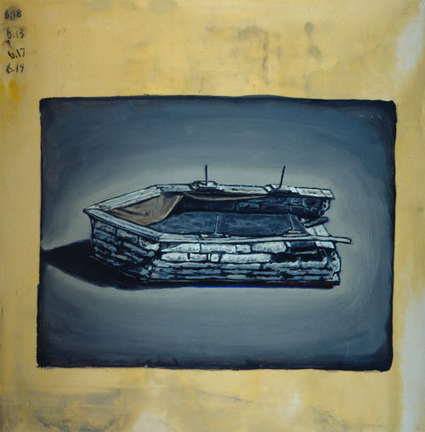
Las Balsas: Las Balsas IV, 1995-1999, Painting - Oils on Plaster over Wood, 8 x 8 x 4” / Box - Oils on Wood, 19.5 x 14 x 7”
Alberto Rey’s Las Balsas IV places the raft pointing leftward in a seemingly stagnant, unmoving stillness. The somber color palette of Las Balsas IV intensifies the trauma of the not so distant past, a trauma that continues to be felt today in the Cuban-American community. From my own perspective, I felt that this boat was pointing left - as if towards the past - and remained unmoving rather than going forward - as though the spectator is seeing into the past from outside the frame of the work. We do not need to actually see the past to have clarity on this crisis because the rafts are living relics, almost religious altars in their own right as well as metaphors of past trauma and injustice. On these rafts, Cuban refugees were robbed of their peace and security, when their freedoms and basic rights were taken away as they set out on their journey. Those who launched the vessels did not know if they would survive this journey just as we today do not know exactly who survived, as the rafts are silent on the outcomes of their trips. Many families lost someone dear to them, in the journeys that occurred, and we will never know the details of their deaths. On these boats, along with hope there was uncertainty and no guarantee of peace or security. For the artist, the pain of loss represented by these rafts is personal. One of Rey’s grandmother, who tried to make the journey to the United States via an overcrowded boat, was lost when it capsized after the engine exploded.
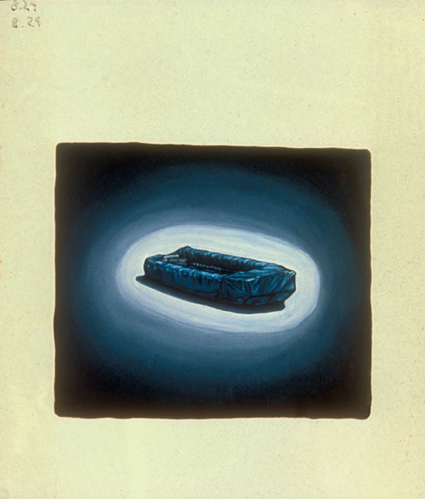
Las Balsas: Las Balsas IX, 1995-1999, Painting - Oils on Plaster over Wood, 8 x 11 x 2.5” / Box - Oils on Wood, 19.5 x 14 x 7”
Alberto Rey’s Las Balsas IX resonates with me differently from Las Balsas IV because it is pointed in the opposite direction, facing to the right. The raft looks as though it is slowly gliding and moving towards the future outside the picture frame. The series Las Balsas speaks not only to the trauma of the past but the alarming loss of human rights that has happened with so many global groups, who set out in sea craft towards a hope for freedom. Often, such refugees find that they are pushed back from the shore and returned to a country that will now persecute them for their departure. This creates compounded sense of trauma. For those who experience “pushback,” the waters on which they set out for freedom become a new zone of danger. In Balsas IX, Rey utilizes color and form to create a white spotlight around the boat, generating a symbolic space that provides the spectator with a point of view into the possible events that were enacted on the raft. Such a perspective is an invitation for participation and for playing a more active role in responding to the ongoing, international human-rights crises that are creating millions of displaced global populations, which continue challenging governments and individuals to find resolutions.
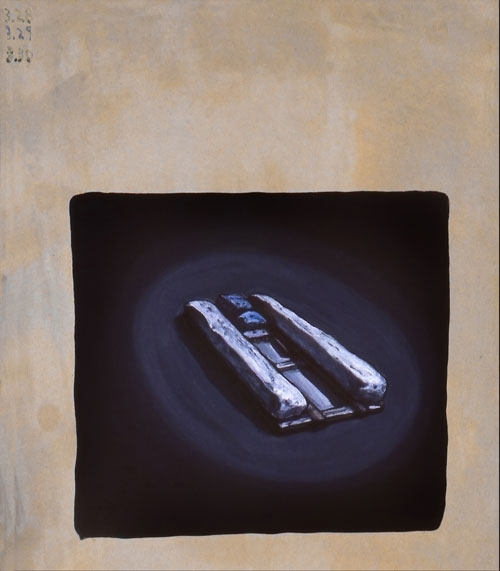
Las Balsas: Las Balsas XII, 1995-1999, Painting - Oils on Plaster over Wood, 8 x 11 x 2.5” / Box - Oils on Wood, 19.5 x 14 x 7”
Rey’s Las Balsas XII offers a perspective that enables the spectator to take a bird’s-eye-view, looking down on the empty raft from above. There is an effect, in the composition of this work, that is reminiscent of the stillness of a stagnant place in the sea, where hope ebbs. In the boat’s coffin-like shape and in black box that the painting is housed in, this resonance suggests that for too many such vessels become actual coffins. As Rey’s series unfolds, there are evocations of other crises, where people died and one thinks of revolutions, wars, famine, ecological disasters and the desperation of peoples in prisons or concentration camps from which they seek to escape by taking to the waters that promise escape and freedom. Rey’s rafts thus serve, as reminders, of great human tragedy and of unknown fates. For many Cubans, as for other similar populations, the reality of tragic outcomes is the end. For such, Rey’s rafts become an invitation to spectators to meditate on the events that can accompany tragedy and to consider what happened to each individual on these rafts.
Rey’s Las Balsas IV, Las Balsas IX, and Las Balsas XII are representative of the Las Balsas Series because they encompass the tragedy of the past, continuing into the present and what the significance of past events mean to the future. They are explanatory of the loss of human rights that occurred and continues to occur and to the suffering on similar vessels, wherein the tragic outcome can rob individuals and their families of their lives. Departing from this exhibition, is itself a meditative experience, as the spectator leaves considering the significance of the subject Rey explored and the unanswered questions he has raised with his enigmatic images. As they do so, I seek to give space for Rey’s audience to allow the somber silence of his works to transport them into the open ocean, crowded onto a raft knowing that the waves might envelop you, yet remaining hopeful for a better life.
I ask those who gaze at these works to imagine the dark turbulent ocean and the fear of those traveling with their families on vessels like the Las Balsas XII and the threat of the boat and it inhabitants being pulled to the ocean’s depths. Keeping in mind that every day hundreds of people around the world are facing this reality as they forfeit their lives for something safer and better and the critical need for shared humanity and empathy. As human rights violations such as ‘pushback’ endanger these refugees even further, through Rey’s work it is possible for all of us to put ourselves in the position of these refugees. Rey’s work gives us all the opportunity to mediate and hopefully transform his audiences into advocates for a future that respects the lives and human rights of refugees and all people, for that matter.

